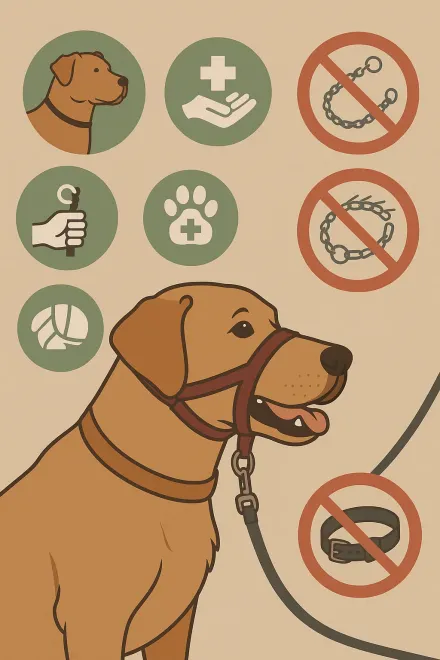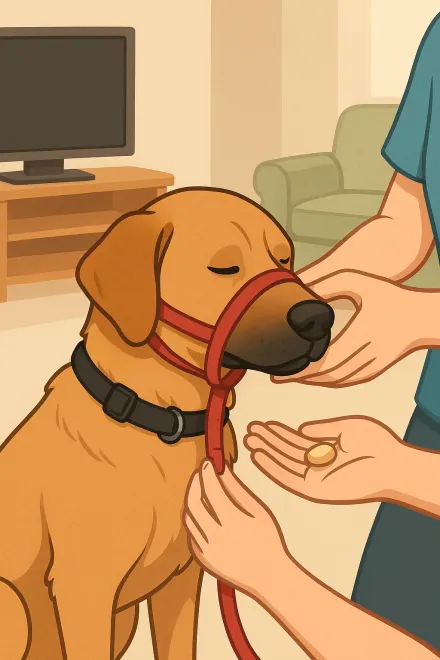Halti no-pull collar: what it is, how it works & when to use it
The Halti no-pull collar is one of the most recommended tools by dog trainers and veterinarians to improve walks with dogs that pull excessively on the leash. Unlike choke chains or basic harnesses, the Halti is based on an ergonomic design inspired by horse headcollars, allowing you to gently guide the dog’s head direction, making control easier without causing pain or harm. This system is not a miracle accessory nor a substitute for training, but it becomes a valuable aid for safer and calmer walks for both the dog and the handler.
Understanding how a Halti no-pull collar works and when it is best to use it is key to taking advantage of its benefits and avoiding misuse. In this guide, you’ll find detailed information about its function, advantages, usage tips, trainer recommendations, and real owner experiences.
See best Halti collar deals on Amazon
How the Halti no-pull collar works
The Halti collar works on a simple principle: controlling the dog’s head direction to make guiding movements easier. Just like horse reins, the Halti allows a slight leash movement to redirect the dog’s attention toward you. This reduces the pulling force and improves communication between handler and dog.
The design fits over the muzzle, with one strap gently around the dog’s snout and another around the neck, both connected to the leash. It is not a muzzle, since the dog can open its mouth, pant, drink, and play without restrictions. It is designed for training and controlled walks.
The Halti is especially useful for large or strong dogs, which can be difficult to manage with a regular harness. It is also recommended for young dogs still learning to walk properly on the leash, always under supervision and with gradual introduction for a positive association.
In short, the Halti no-pull collar provides an effective and safe way to manage leash-pulling behavior, improving walk experiences for both dog and owner.
Advantages of the Halti collar over other systems
The Halti offers several advantages over traditional collars or even some no-pull harnesses. Its main benefit is the gentle yet effective control, allowing redirection without painful pressure. This makes it an ethical alternative to choke, prong, or electric collars, which can cause physical injuries and emotional issues in dogs.
Some of the most notable advantages include:
- Better control of large dogs: especially useful for breeds like Labradors, German Shepherds, or Pitbulls with great physical strength.
- Ergonomic design: allows the dog to pant, drink water, and open its mouth normally.
- Training tool: helps teach the dog to walk calmly without pulling, reinforcing handler-dog communication.
- Injury reduction: decreases neck and spine pressure, avoiding sudden jerks.
- Adaptability: available in different sizes and models for various muzzle shapes.
It’s important to highlight that the Halti is not a standalone solution. For long-lasting results, it must be combined with positive reinforcement training, patience, and consistency. Used correctly, it not only improves walks but also strengthens the dog-human bond.


Tips for correctly using a Halti
Before starting with a Halti collar, it’s essential to use it properly so the dog accepts it and feels comfortable. One key factor is gradual adaptation. Don’t just put it on and go for a walk; instead, let the dog sniff it, associate it with treats, and use it in short sessions at home before heading outside.
Some practical tips include:
- Positive association: every time you put on the Halti, pair it with treats or play so the dog perceives it positively.
- Proper fit: it should be snug but not tight. The muzzle strap must not prevent the dog from opening its mouth.
- Short sessions: at first, limit usage time so the dog doesn’t get stressed.
- Avoid harsh tugs: even though the Halti helps with control, it should never be used punitively.
- Supervision: dogs should not be left wearing the Halti indoors or unsupervised.
The key is to use it as a training tool, not as punishment. The goal is to teach the dog to walk calmly without relying on the accessory in the long run.
Frequently asked questions about the Halti collar
Does the Halti hurt dogs?
No, the Halti is not designed to cause pain. Unlike choke or prong collars, it works by gently redirecting the dog’s head. Proper fitting and avoiding harsh tugs are essential. Used correctly, it is a safe accessory that respects animal welfare.
Is the Halti the same as a muzzle?
No. Although it fits over the muzzle, the Halti does not prevent the dog from opening its mouth, drinking, playing, or panting. Its function is not to stop biting but to guide head direction and reduce pulling during walks. Mistaking it for a muzzle is a common misconception among those unfamiliar with it.
Is the Halti suitable for all breeds?
The Halti is available in different sizes, making it suitable for most dogs. However, for short-muzzled breeds like Bulldogs or Pugs, it may not fit properly. In such cases, alternatives like no-pull harnesses are recommended.
How long does it take for a dog to get used to the Halti?
Adaptation time varies depending on the dog. Some accept it from the first walk, while others may take days or weeks. The most important factor is gradual introduction, always paired with treats, play, and positive reinforcement so the dog associates the Halti with pleasant experiences.
Can I leave my dog wearing the Halti indoors?
It is not recommended. The Halti is an accessory for walks and should be used under supervision. Leaving it on indoors may cause discomfort or risk of snagging on objects. The ideal practice is to put it on just before going out and remove it upon returning.
Which is better: a Halti or a no-pull harness?
Both options are valid and depend on the dog’s needs and handler’s comfort. The Halti offers greater control over large or strong dogs, while no-pull harnesses may be more suitable for short-muzzled or sensitive dogs. Many trainers recommend trying both tools to see which best suits the dog-handler pair.
Does the Halti replace training?
No, the Halti is only a support tool. It helps with control during walks, but leash-pulling behavior must be addressed through positive training, patience, and consistency. Used alongside proper education, it speeds up results and improves coexistence.
